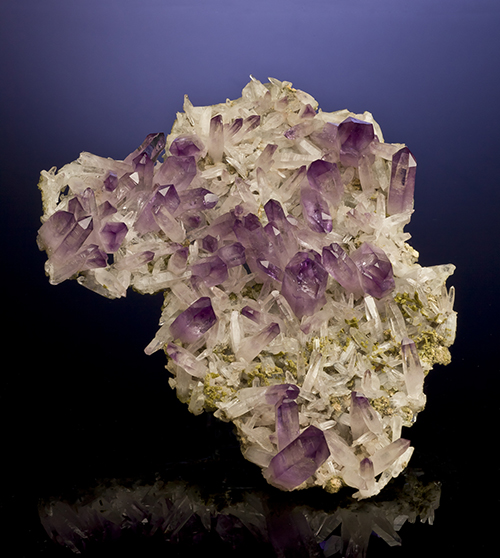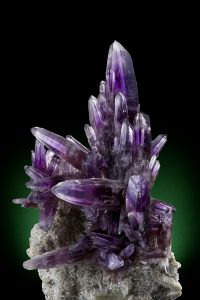
Editor’s Note: This is one of 10 Mexican locales recognized for mineral production. View the rest of the list as part of an article by Peter Megaw>>>
These two districts lie on opposite sides of southern Mexico but deserve treatment together because their geology is similar and each produces superb, but distinctive, amethyst quartz in quantity. Las Vigas remains in active production, while Amatitlan is currently dormant (Lieber and Frenzel, 2003; Ontiveros, et al., 2004). Both are skarn deposits developed in limestone around the margins of otherwise barren intrusions. Silica-rich fluids expelled from the cooling intrusions invaded the limestone, converting it to grossular-andradite garnet and leaving holes for large quartz crystals to grow in. The fluids were iron-rich, so the quartz is purple amethyst. The similarities end there; the amethyst from these two deposits are distinctively different and instantly recognizable.
Las Vigas amethyst tends to form simple elongate lustrous prismatic crystals with simple sharp rhombohedral terminations. These often form spray-like groups with multiple crystals splaying outwards from a common base; a high percentage come free from their matrix, so free-standing groups or singles are common. Hopper growth is common as are fluid inclusions with moving bubbles (enhydros). Doubly terminated crystals are also common; Japan-Law twins are rare but exceptionally beautiful. When matrix is present it tends to be bleached-looking silicified limestone, commonly spotted with tiny green grossular garnets or epidote.

Recently, a number of very attractive specimens featuring a matrix of grayish-brown scalenohedral calcites to 6 cm sprinkled with 3-8 cm doubly-terminated amethysts have emerged. Overall, amethyst color varies from pocket to pocket and runs the gamut from pale lilac to royal purple, with the color being most intense towards the terminations. Recently, color intensity seems inversely proportional to crystal size: larger crystals having weaker color. T’was not always so: historically, groups of 6-8 cm crystals with deep purple color were recovered. Today this color quality is only seen in sub-centimeter size crystals.
Amatitlan amethyst is immediately distinguishable from Las Vigas specimens. The crystals tend to be bigger than Las Vigas, commonly reaching 10 to 20 cm in length and are more robust. They almost always have a distinct bulge in their middle with the zone between the base and the bulge often composed of a bundle of individual closely intergrown crystals. Small “parasitic” crystal offshoots from the base are common.
The crystals become simpler prisms past the bulge as they taper towards a sharp rhombohedral termination that tends to look more elongate than those from Las Vigas. Amatitlan amethysts show much darker and more saturated purples than Las Vigas, often being a rich grape gum-ball purple. Their zoning tends to be less pronounced, but there are famous pockets that featured a white outer layer covering a core of deep purple. Amatitlan are often very gemmy, especially towards their terminations, and historically the bulk of the production went for cutting gemstones.














